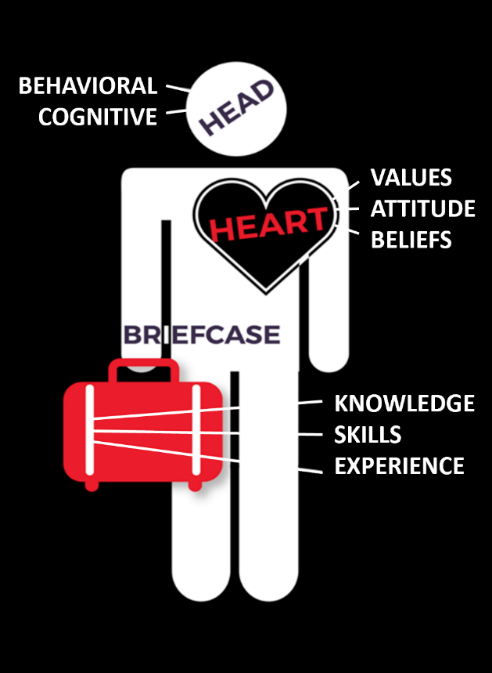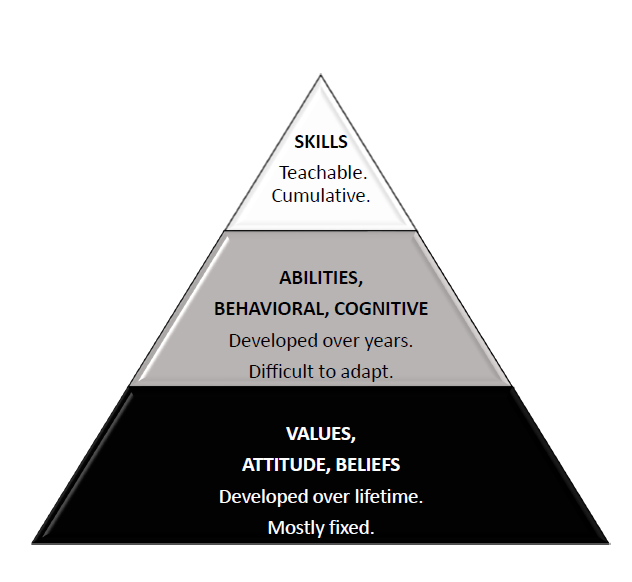|
As I have studied what great organizations do to get great people, I have identified a few defining features. Where most organizations start with skills when hiring new people, the most successful start with culture fit first. To understand this more completely I share the following model in my new book Talent Optimizer. I call it the head, heart, and briefcase. The Head, Heart, and Briefcase• The head consists of the behavioral drives and cognitive abilities the person brings to the job. • The heart refers to a person’s attitude, values, and beliefs. • The briefcase is the person’s knowledge, skills, and experience. When most companies approach hiring, they focus on the briefcase. What skills are needed to do a job, what knowledge or education do we want the person to bring, and what level of experience is required? This briefcase strategy makes sense because these measures are objective and easy to measure. You can screen for the briefcase assets on a resume or job application. In my experience, over 90% of companies focus here when hiring. Are skills or values more important when hiring?When you think about any relationship you’ve ever had, be it with friends or romantic interests, over time you determined if you were right for each other. When you consider your relationships that have lasted, there is most often a core set of shared values and beliefs that unite you. When personal relationships don’t work out, it’s usually due to a mismatch of values and beliefs. For example, perhaps you value building relationships and enjoying a vibrant social life, and your significant other prefers to stay home. The chances are good that this mismatch in values will create friction in your relationship. The challenging part here is that we develop our attitude, values, and beliefs over a lifetime. They are inherently personal and mostly fixed. You should not expect to change someone’s attitude, values, and beliefs. Dev Basu, CEO of Powered by Search, a client of mine, describes values as “factory-installed firmware.” If you want to build a great company, you need to figure out which values and beliefs are important to you, and which you are not willing to tolerate. If you get this part wrong, no amount of team-building or leadership development will solve your team dysfunction. Next, we have the head. The head consists of two parts: cognitive abilities and behavioral drives. As we will explore later, cognitive ability is widely believed to be the most significant predictor of job performance; thus, it is a critical part of the equation. Cognitive ability is, for the most part, a fixed attribute. We either have it, or we don’t. So, it’s best to determine the requirements for a position and assess your candidates for it. Behavioral drives predict our needs and thus, the type of work we will find satisfying. Research suggests that these drives develop over the first twenty or so years of our lives. It is believed that these drives form as a result of the human brains ability to recognize patterns and operate many basic tasks on virtual autopilot. As we experience reality, we learn how to deal with similar situations in similar ways so we can focus our attention on other things. Historically this ability to operate on autopilot allowed us to avoid predators while searching for food, today it results in us behaving in predictable, habitual ways. After these drives form, they remain stable. It is important to note that all behavior is a result of a response to stimuli or motivation. Thus, behavioral drives can be adapted. We can do work that we find unsatisfying, temporarily, if we are motivated to do so. However, in the long run, we tend to gravitate toward the activities we find most enjoyable. This drive to satisfy our needs is why job-slip happens. Someone is hired for a job and initially will do the job precisely as directed. During their probationary period, there is a powerful motivation to keep behaving in a way that’s congruent with the job requirements. Then, once the new hire gets comfortable with the role and the company, they start to do things a bit differently. Little by little, they do activities outside their original scope of work, until one day, they are doing something completely different. People are wired to seek pleasure and avoid pain. In the long run, everyone finds a way to satisfy their behavioral needs—so it’s best to find out what these needs are, early on, and align them with a role that fits. Values, Abilities, and Skills PyramidWhy do Values matter when hiring new employees?The Values, Abilities, and Skills Pyramid graphically represents the relative size and malleability of the major traits you will encounter from each employee. You can see the bottom of the figure contains the most inflexible traits, while the top has the most malleable traits. Attitude, personal values, and beliefs are at the foundation—they are the most fixed and must align with the shared values of the leaders of the business. If you find people with shared values and beliefs first, chances are you will always have a place for them in your organization as it grows. If you get the values part wrong, it doesn’t matter if the employee has the skills you need or the right mix of behaviors. Incongruent values will cause friction in your business and divide the team. If you have large factions within your business with opposing values, you may have a dysfunctional culture and have difficulty managing some of your major players. Behaviors and abilities are in the middle of the pyramid, indicating that these traits can be changed temporarily but that one shouldn’t expect people to sustain these changes over the long run. Again, it’s critical to align natural behaviors and abilities with the work that the position requires. Finally, skills are at the top of the model. Skills are at the top because they are variable. If you get the lower levels of the pyramid right, you can typically train new skills. With the rate of technology change today, the skills that are currently in demand will likely be outdated in just a few years. Thus, skills are the least important part of the equation when building a robust and sustainable culture. Note: I realize that some jobs require specialized skills. I will discuss skills and how to assess proficiency in a future post. For now, recognize that hiring skills without regard to values and beliefs is a recipe for failure. In my new book Talent Optimizer, I share several examples of how I’ve worked with clients to define a structure recruiting and employee engagement process. Starting with values, then abilities then skills. Defining meaningful core values is often one of the most difficult parts of this process. In my experience I believe this stems for a misunderstanding of what core values are meant to do. I often find that leaders have read books like Good to Great by Jim Collins, or paid an organization like the BDC to do a business planning session, only to end up with vanilla meaningless values. They put these values like integrity, respect and teamwork up on the wall and thing this will fix their culture issue. This is now how core values work. What is the difference between values and core values?Core values are the defining characteristics that make your cultural norms different from your competition. In Talent Optimizer I share the following core values definition: A set of principles and shared views that you expect everyone in the company to agree to. These principles and shared views should be unique to your culture and they must be meaningful to the employees who abide by them. A value like integrity on the other hand should be considered a basic expectation for all people in all companies to live by. If it doesn’t define something unique to your people and your culture, you should not consider it a core value. Are there risks in establishing core values?In short, the answer is yes. There are real risks. Consider if your leadership team defines your core values and there is one or more person on the leadership team that does not fit with these core values. If this happens, you have two choices, redefine your core values or remove these individuals from the leadership team if they don’t start living up to the core values. Further, if you get this part wrong, and your team sets core values that are not meaningful and real, you run a risk of appearing hypocritical to your employees. If you and your leadership team are not 100% committed to establishing real core values and firing people that do not live up to the core values, then don’t start the process. Are there organizations that core values do not work in?In my experience there are two types of organizations. First, there are organizations run as dictatorships, where a senior leader sets the direction and everyone in the organization must follow. The second type of organization establishes a leadership team where decision making is made at multiple levels and the team selflessly pursues the company’s mission or purpose. Core values do not work in dictatorships. If you run your organization from the top and down, core values will probably not work for you. If on the other hand, you believe in establishing a strong leadership team, core values will unite your people to rally around your company’s mission.
0 Comments
Leave a Reply. |
Archives
January 2020
Categories |
About Me
|
Consulting
|
Contact
|
Blog
|
CheckUp |
Copyright © 2015-2020



 RSS Feed
RSS Feed